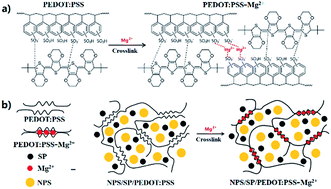当前位置:
X-MOL 学术
›
Sustain. Energy Fuels
›
论文详情
Our official English website, www.x-mol.net, welcomes your
feedback! (Note: you will need to create a separate account there.)
Ionically cross-linked PEDOT:PSS as a multi-functional conductive binder for high-performance lithium–sulfur batteries†
Sustainable Energy & Fuels ( IF 5.0 ) Pub Date : 2018-04-23 00:00:00 , DOI: 10.1039/c8se00167g Longlong Yan 1, 2, 3, 4, 5 , Xiguang Gao 1, 2, 3, 4, 5 , Joseph Palathinkal Thomas 3, 4, 5, 6 , Jenner Ngai 1, 2, 3, 4, 5 , Haig Altounian 1, 2, 3, 4, 5 , Kam Tong Leung 3, 4, 5, 6 , Yuezhong Meng 7, 8, 9, 10, 11 , Yuning Li 1, 2, 3, 4, 5
Sustainable Energy & Fuels ( IF 5.0 ) Pub Date : 2018-04-23 00:00:00 , DOI: 10.1039/c8se00167g Longlong Yan 1, 2, 3, 4, 5 , Xiguang Gao 1, 2, 3, 4, 5 , Joseph Palathinkal Thomas 3, 4, 5, 6 , Jenner Ngai 1, 2, 3, 4, 5 , Haig Altounian 1, 2, 3, 4, 5 , Kam Tong Leung 3, 4, 5, 6 , Yuezhong Meng 7, 8, 9, 10, 11 , Yuning Li 1, 2, 3, 4, 5
Affiliation

|
Despite their very high theoretical specific capacity, lithium–sulfur (Li–S) batteries still face issues such as low sulfur utilization and poor long-term cycling stability due to the low conductivity of sulfur, lithium polysulfide shuttle effect and large volume change during discharge–charge processes. This work uses a novel multi-functional polymer binder, PEDOT:PSS-Mg2+, to address the above issues. First, PEDOT:PSS is a highly conductive polymer, which improves the conductivity of the cathode composite. Second, cross-linking of PEDOT:PSS with Mg2+ forms a robust network that is able to endure the drastic volume change of the cathode during discharge/charge. Third, the abundant oxygen atoms present in PEDOT:PSS strongly interact with lithium polysulfides to suppress the shuttle effect. Li–S batteries with this new binder showed high initial specific capacity of up to 1097 mA h g−1 and high capacity retention of up to 74% after 250 cycles at 0.5C with a sulfur content of 70 wt% in the cathode, which are significant improvements compared with the corresponding Li–S batteries with a conventional PVDF binder. Additionally, preparation of the cathode material with this new binder uses water as the solvent, avoiding the use of toxic organic solvents such as N-methylpyrrolidone (NMP).
中文翻译:

离子交联的PEDOT:PSS作为高性能锂硫电池的多功能导电粘合剂†
尽管锂-硫(Li-S)电池具有很高的理论比容量,但由于硫的电导率低,多硫化锂的穿梭效应以及放电过程中的体积变化较大,因此仍然面临诸如硫利用率低和长期循环稳定性差的问题。 –充电过程。这项工作使用了一种新型的多功能聚合物粘合剂PEDOT:PSS-Mg 2+来解决上述问题。首先,PEDOT:PSS是一种高导电性聚合物,可提高阴极复合材料的电导率。第二,PEDOT:PSS与Mg 2+的交联形成一个坚固的网络,该网络能够承受放电/充电过程中阴极的急剧体积变化。第三,PEDOT:PSS中存在的大量氧原子与多硫化锂强烈相互作用,从而抑制了穿梭效应。使用这种新粘合剂的Li–S电池在0.5C下250次循环后,初始比容量高达1097 mA hg -1,高容量保持率高达74%,阴极中的硫含量为70 wt%。与使用传统PVDF粘合剂的相应Li–S电池相比,有了显着的改进。另外,用这种新的粘合剂制备阴极材料时,用水作为溶剂,避免使用有毒的有机溶剂,例如N-甲基吡咯烷酮(NMP)。
更新日期:2018-04-23
中文翻译:

离子交联的PEDOT:PSS作为高性能锂硫电池的多功能导电粘合剂†
尽管锂-硫(Li-S)电池具有很高的理论比容量,但由于硫的电导率低,多硫化锂的穿梭效应以及放电过程中的体积变化较大,因此仍然面临诸如硫利用率低和长期循环稳定性差的问题。 –充电过程。这项工作使用了一种新型的多功能聚合物粘合剂PEDOT:PSS-Mg 2+来解决上述问题。首先,PEDOT:PSS是一种高导电性聚合物,可提高阴极复合材料的电导率。第二,PEDOT:PSS与Mg 2+的交联形成一个坚固的网络,该网络能够承受放电/充电过程中阴极的急剧体积变化。第三,PEDOT:PSS中存在的大量氧原子与多硫化锂强烈相互作用,从而抑制了穿梭效应。使用这种新粘合剂的Li–S电池在0.5C下250次循环后,初始比容量高达1097 mA hg -1,高容量保持率高达74%,阴极中的硫含量为70 wt%。与使用传统PVDF粘合剂的相应Li–S电池相比,有了显着的改进。另外,用这种新的粘合剂制备阴极材料时,用水作为溶剂,避免使用有毒的有机溶剂,例如N-甲基吡咯烷酮(NMP)。











































 京公网安备 11010802027423号
京公网安备 11010802027423号